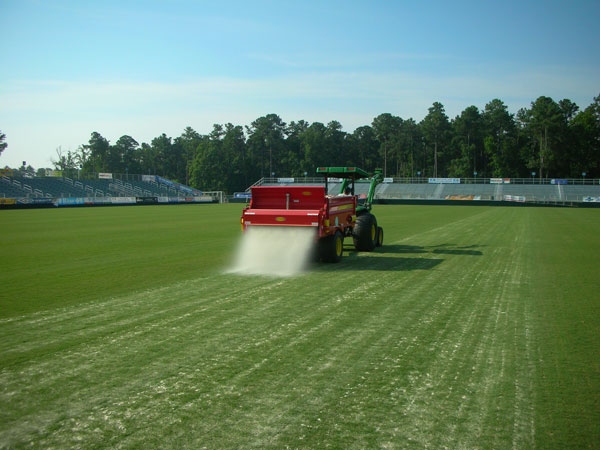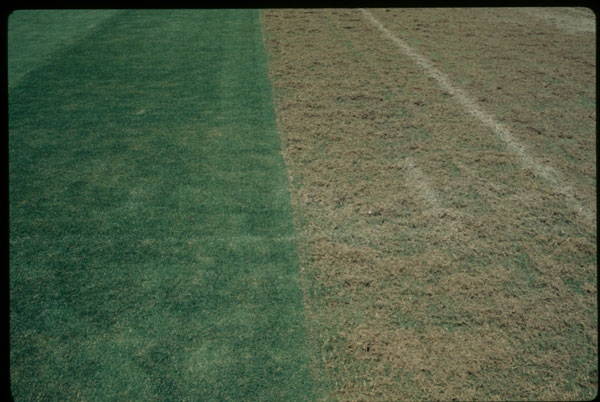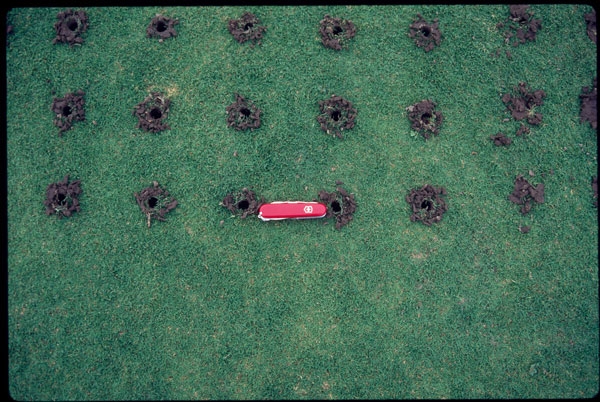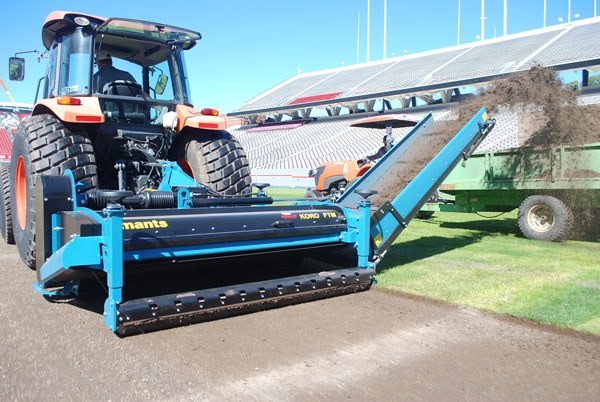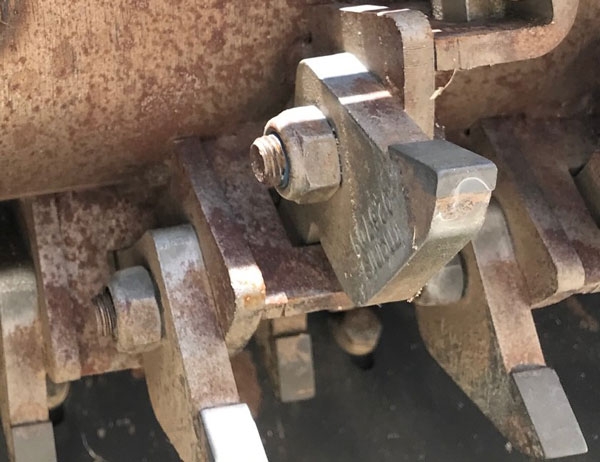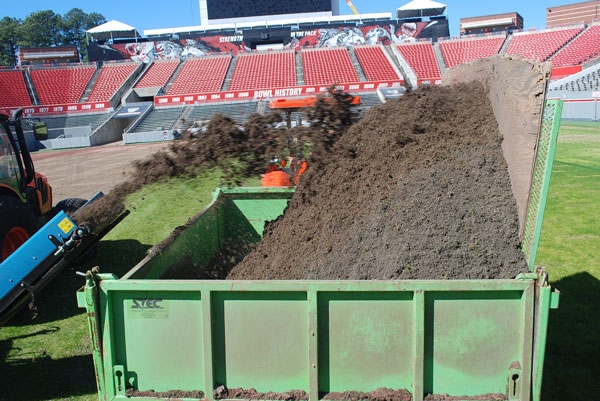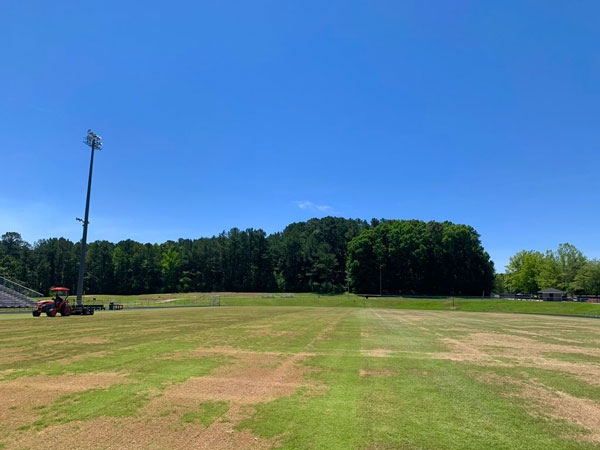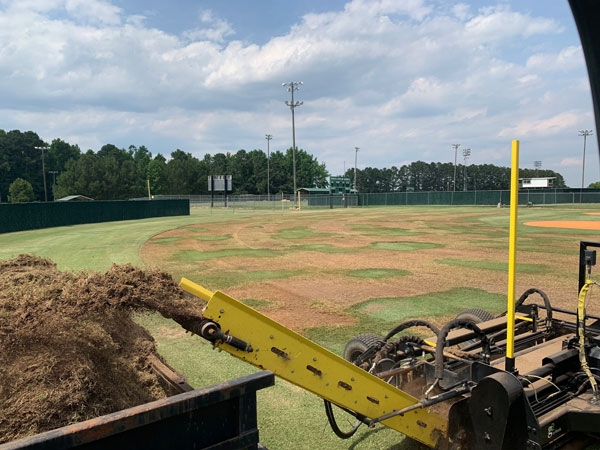Introduction
Bermudagrass is often planted on golf courses and sports fields in North Carolina because of its excellent quality, stress tolerance, and rapid establishment and recovery rates. Despite its many attributes, bermudagrass produces thatch—a layer of living and dead plant material that forms between green turfgrass shoots and the soil surface. At moderate depths (< 0.5 inch), thatch protects bermudagrass crowns from traffic, moderates soil temperatures, and provides cushioning for falling athletes (Figure 1). However, bermudagrass health, playability, and soil physical properties are compromised when thatch levels exceed 0.5-inch depth (Figure 2). Excessive thatch reduces bermudagrass drought tolerance; increases the incidence of localized dry spots; and slows water, air, and chemical (fertilizer and pesticide) movement into the soil. Excessive thatch increases bermudagrass susceptibility to winterkill and the disease spring dead spot.
Soil microbes—bacteria and fungi—are responsible for thatch decomposition. When thatch accumulation outpaces microbial degradation, turfgrass managers must use cultural practices to manage thatch. Topdressing, the broadcasting of a thin layer of sand or soil across the turfgrass surface, is considered the best cultural practice for controlling thatch accumulation (Figure 3). To be effective, though, topdressing must be performed several times annually during the growing season.
If thatch levels become excessive, topdressing alone becomes ineffective, necessitating mechanical practices instead. These practices are often laborious, expensive, and disruptive of turfgrass quality. Hollow-tine aerification and vertical mowing (Figure 4) are two common cultural practices used to promote better turfgrass growing conditions. These practices can be performed independently or in tandem with each other as well as with topdressing to reduce thatch. Hollow-tine aerification (coring) physically removes and deposits a ‘core’ of turfgrass shoots, thatch, and soil on the surface (Figure 5). When reincorporated, these cores function like topdressing and increase thatch decomposition. Vertical mowing removes thatch with a series of rotating vertical blades that are mounted onto a horizontal shaft (Figure 4). The aggressiveness of aerification and vertical mowing may be adjusted. However, neither impacts the entire surface, and multiple years of both are often necessary to effectively decrease the thatch layer.
Fraise (Fraze) Mowing
Fraise mowing is a highly disruptive cultural practice that enables turfgrass managers to (potentially) remove all thatch without the added steps and expenses of total renovation or gradual thatch reduction (Figure 6). Fraise mowing is more efficient at removing thatch than all other cultural practices. Despite being around since the mid-1990’s, there is limited available knowledge about this practice.
Fraise mowers function similarly to vertical mowers. Both have a series of vertical blades mounted on a horizontal rotating shaft or rotor (Figure 7). Fraise mowing’s impact, however, is absolute and encompasses the entire surface to (potentially) 2-inch depths. Thatch management is the main application for fraise mowing; however, it is also used in some niche settings: renovation, weed control, and sod production.
Tractor-mounted and self-propelled walk-behind fraise mowing units are available (Figure 8). Tractor-mounted units are powered by the tractor’s power take-off (PTO) and hydraulics. An attached, adjustable discharge chute on tractor-mounted units enables the tidy disposal of all debris into accompanying service vehicles. Walk-behind units, however, do not have an attached discharge chute, and all generated debris must be physically removed. A variety of models is available, which vary in working width, rotor type, blades, and horsepower requirements.
Fraise Mowing Process
- Remove or mark irrigation heads and boxes
- Determine fraise mowing depth with test strips (preferably in out-of-play areas).
- Target depths may be achieved with multiple shallow passes versus a single deeper pass.
- When fraise mowing:
- Overlap minimally (< 6 inches) and do not leave any uncut ribbons.
- Deposit debris directly into accompanying service vehicles.
- Monitor discharge chute and debris positions. Service vehicle operators should adjust their speeds to distribute debris evenly in their beds.
- Clean up any spills, especially from future passes.
- Do not fraise mow mounds or dips. Fraise mowers will gouge or miss these areas (respectively) and disrupt their grades.
- Stage debris to ensure equipment does not have to travel an unnecessary distance to dump debris.
- Debris may be disposed on-site or hauled off-site.
Fraise Mowing Considerations
Fraise mowing has multiple benefits. However, before fraise mowing turfgrass managers should consider the associated costs as well as how to manage the large volume of debris fraise mowing generates.
Costs
Fraise mowing is not cheap. The cost of tractor-mounted units depends on their size, manufacturer, and rotor type. New small units (4-foot working width) can cost $25,000 or more; costs increase incrementally with larger working widths. A suitable tractor with sufficient horsepower and high-flow hydraulics is necessary to run a fraise mower. Small fraise mowers require a tractor with ≥ 35 horsepower to run them, which usually cost $23,000 or more (new). Multiple utility vehicles and/ dump trailers are necessary to receive fraise mowing debris. Multiple service vehicles (such as the Toro Workman and John Deere Pro Gators, costing $25,000 or more if new) or dump trailers (ranging between $1,050 to $4,300, new) will be needed to accept material. As previously mentioned, debris must be discarded either on- or off-site. Off-site removal will require additional hauling and disposal charges. For example, the average cost of renting a 40-cubic-yard dumpster is $580 (ranging between $400 and $900). Other expenses include man-hours to fraise mow, as well as to remove, re-install, and adjust irrigation heads and valve boxes. As a reference, fraise mowing an American football field with a 4-foot-wide unit will require 4.5 to 5 hours with sufficient support vehicles and staff. Additional fertilizer (0.75 to 1.0 pound of nitrogen (N) per 1,000 square feet) will be needed to hasten bermudagrass recovery after fraise mowing.
Some facilities may find the time, costs, and coordination of in-house fraise mowing to be overwhelming. If so, group purchasing and equipment sharing with neighboring facilities may be acceptable options to offset the high overhead costs of purchasing a fraise mower and multiple service vehicles.
Hiring reputable fraise mowing contractors may be a viable option, as well. Their rates are variable, are usually calculated on a square foot basis, and range from $0.10 to $0.25 per square foot. Again, the costs may seem overwhelming; however, fraise mowing has the potential to remove all thatch in a single event, versus multiple vertical mowing, aerification, and topdressing events over several years to achieve similar results.
Facility Downtime
Fraise mowing is not for the faint of heart. It produces an unsightly surface for at least three weeks until bermudagrass recovers. To avoid any backlash, facility management and end-users should be well informed before fraise mowing. All unnecessary traffic should be withheld on treated areas until bermudagrass fully recovers. This downtime will decrease revenues for golf and athletic facilities.
Debris
Fraise mowing generates a lot of debris, which is composed of plant litter (including viable sprigs) and soil (Figure 9). The amount of debris generated is proportional to cutting depth, where increasing depths generate more debris. As an example, fraise mowing an acre of bermudagrass to 0.5-inch depth yielded 4,822 cubic feet (~180 cubic yards) of debris that weighed approximately 77 tons (depending on soil moisture). Therefore, proper support staff and equipment are essential to efficiently fraise mow a facility. Multiple utility vehicles should be present to receive and transport debris. Tow-behind dump trailers are especially useful (Figure 10). Dumping areas should be relatively close, and debris staging areas help to expedite fraise mowing. Debris left on site may be composted, piled, or used to re-establish bare areas. If space is limited, debris must be hauled off site for disposal, though this will likely incur hundreds to thousands of extra dollars. Using the previous numbers, five 40-yard dumpers would be necessary for the ~180 cubic yards of debris generated from fraise mowing an acre of bermudagrass to 0.5-inch depth. At an average rental cost of $580 per dumpster, removal of debris off site would cost an additional $2,900!
Specific Uses
Thatch Management
Although highly disruptive, fraise mowing provides turf managers the option to completely remove all thatch in a single pass. Traditional cultural practices, aerification, topdressing, and vertical mowing all require repeated applications over a number of years to reduce thatch content. Although these practices are less disruptive of turfgrass aesthetics in the short term, their capacity to decrease thatch is far inferior to fraise mowing.
Renovation
Fraise mowers are invaluable renovation tools for sports turf and golf courses. Undesirable or damaged areas can be easily fraise mowed (‘hollowed-out’ or ‘koro-ed’) to a uniform depth and resodded. Areas can range from small, worn, or painted areas (less than 100 square feet) to multiple acres. This practice is especially prevalent on professional sports fields. Minimal re-grading (if any) is required afterwards, and fraise mowing is more efficient than previous renovation methods that employed sod cutting, excavating, filling, and regrading. Fraise mowing is occasionally referred to as “turf planing” because of its ability to correct (or level) irregular surface grades (Figure 11a and Figure 11b). These include lips around baseball and softball infields and warning tracks, as well as putting green collars (Figure 12). Turf planing may be performed to level uneven, bumpy golf tee boxes, fairways, and sports fields. Treated areas may regrow from unmown stolons and rhizomes following shallow fraise mowing depths. However, replanting with sod or sprigs may be necessary following deep, aggressive fraise mowing.
Fraise mowing’s functional depths of 2 inches or less) overlap with compaction depths from routine traffic (usually 3 inches or less). Field studies at NC State demonstrated the potential of fraise mowing at various depths to relieve shallow soil compaction in heavily trafficked sports fields. Fraise mowing at 0.8-inch depth decreased soil surface hardness and soil resistance and increased the drainage rate in sandy sports fields.
Similarly, fraise mowing to a 2-inch depth increased drainage of a highly trafficked sandy soil by more than 115%. These results indicated compaction relief and demonstrated fraise mowing’s potential to remove surface compaction in heavily trafficked sports fields.
Sod Production
Blades may be removed from certain rotors on specific fraise mower models to partially impact the surface. This is known as “finesse mowing.” Sod farms often fraise mow or “finesse mow” to generate viable sprigs. Sprigs are pieces of stolons and rhizomes with multiple nodes that may be planted as a cheaper alternative to sod. These sprigs are either sold or used to expand the sod farm’s inventory. The creeping growth habit of bermudagrass and zoysiagrass enable them to completely recover from this sprig harvest within weeks, leaving sod farms with a virtually endless supply of sprigs.
Weed Control
Annual bluegrass (Poa annua) has been labelled the worst weed in managed turfgrass because of its unsightly yellowish-green color, prolific seed production, and ever-growing herbicide resistance. Fraise mowing provides a mechanical means to decrease annual bluegrass pressure in bermudagrass and other turfgrasses (Baker et al., 2005; Carroll et al., 2020). Fraise mowing works by physically removing annual bluegrass plants, as well as its shallow (1-inch deep or less) seedbank (the accumulated seed in the soil). Therefore, fraise mowing has the potential added benefit of decreasing future annual bluegrass generations.
These benefits may apply to other annual weeds. Initial research has demonstrated that fraise mowing up to 0.38 inch deep in July decreased smooth crabgrass pressure in bermudagrass.
However, fraise mowing can backfire and increase weed pressure if it is performed too early or late in the growing season. Increased winter weed pressure can be expected if fraise mowing is performed in the late summer and the bermudagrass has not sufficiently recovered. Similarly, increased crabgrass pressure was observed after fraise mowing in the early spring in fine fescue golf course roughs (Sitko, 2020). The application of a pre-emergent herbicide (preferably oxadiazon) after fraise mowing is recommended to limit weed reinfestations. Oxadiazon is preferable after fraise mowing, especially on sports fields, because it does not hinder bermudagrass regrowth.
Because weed seed is present within fraise mowing debris, tidiness is imperative to minimize recontamination. Thus, all debris, including any spills should be collected.
Fraise Mowing Affects Aesthetics and Soil Physical Properties
Aesthetics
Fraise mowing temporarily decreases turfgrass quality for weeks until bermudagrass recovers. This temporary setback is offset by the long-term reduction in thatch content. Thatch causes mowers to settle and increases the chances of uneven cutting heights and scalping (the drastic, sudden removal of leaf tissue). Fraise mowing reduces future chances of scalping and poor turfgrass aesthetics.
Soil Physical Properties
Fraise mowing affects soil surface hardness, traction, and drainage. As fraise mowing removes the cushioning thatch layer, it creates a firmer, faster playing surface. This will likely increase ball roll distances on fairways and sports fields as well as athletes’ pace. Fraise mowing depth and soil type will affect athletes’ traction. Traction will decrease with increasing fraise mowing depth in sandy soils. This occurs because sandy soils need turfgrass roots, rhizomes, and stolons for stability, which fraise mowing removes. However, traction will increase when increasing fraise mowing depth in heavier soils. Although increasing fraise mowing depths removes more thatch, soil drainage (surprisingly) decreases with increased fraise mowing depth in sandy soils. Despite these changes, observed soil physical properties were within acceptable, “safe” ranges for soil hardness (less than 100 gravities), traction (greater than 20 N·m), and drainage (more than 6 inches hr-1 ) once the bermudagrass fully recovered from fraise mowing. Play should therefore be suspended until the bermudagrass completely recovers.
Recovery Rate
There are multiple factors that impact bermudagrass’ recovery rate from fraise mowing: time of year, health and condition of the existing turfgrass stand, cutting depth, tidiness, fertility, topdressing, mowing, irrigation, and core aerification.
Time of Year
Bermudagrass recovery is dependent on air temperatures after fraise mowing. Although bermudagrass will “green-up” when daytime air temperatures exceed 50°F, active bermudagrass growth does not occur until day- and nighttime air temperatures exceed 85 and 65°F, respectively, for more than one week. Therefore, bermudagrass should be fraise mowed when it’s growing optimally (from mid-to-late May until early August in eastern NC, and from mid-to-late June until late July in western NC) to ensure fast recovery. Bermudagrass decline or death, as well as increased winter weed pressure, may result if fraise mowing is performed after mid-August. Similarly, bare ground will persist if bermudagrass is fraise mowed before it begins actively growing. Increased summer weed pressure may result if bermudagrass is fraise mowed too early in the spring.
Health and Condition of Existing Stand
After fraise mowing, bermudagrass recovers from nodes on remaining stolons and rhizomes. If turf coverage is poor before fraise mowing, bare areas will persist after fraise mowing. The old adage “garbage in, garbage out” pertains to fraise mowing. Bare areas (without any intact stolons or rhizomes) greater than 1 foot in diameter should be sprigged, plugged, or sodded after fraise mowing to accelerate recovery.
Cutting Depth
Fraise mowing depth has a profound effect on bermudagrass recovery. As fraise mowing depths increases, more rhizomes, stolons, and nodes from which bermudagrass can regrow are removed. Thus, longer recovery times can be anticipated when increasing cutting depths. Shallow cutting depths (0.25 inches) can recover in three weeks after fraise mowing; however, 1-inch cutting depths may require six weeks or longer to recover.
Tidiness
Tractor-mounted fraise mowers are equipped with a discharge chute that allows debris to be directly discharged into accompanying service vehicles. With skillful operators and the correct receiving equipment, a tidy surface will remain after fraise mowing. Any missed debris should be removed from future passes to ensure a uniform cutting depth. Any remaining debris after fraise mowing should be collected to prevent turfgrass smothering, delayed turfgrass recovery, and weed seed contamination. To ensure a clean cut, fraise mowing should be performed when soil moisture is at field capacity. Smeared debris, unsightly clumps, and poor clean-up will result if fraise mowing is performed when soil moisture is high. Conversely, dusty conditions and tedious clean-up will ensue if the soil is too dry during fraise mowing.
Fertility
Fertility recommendations are based on recent fraise mowing research and may not fit within typically suggested fertility programs. Nitrogen fertilizer should be applied following fraise mowing to speed up bermudagrass recovery. Research suggests that granular fertilizer should be applied one week after fraise mowing. This delay will limit the chances of products moving laterally with heavy rainfall and irrigation. Granular, water soluble (quick release) nitrogen should be applied at half a pound of N per 1,000 square feet once a week to hasten bermudagrass recovery. At this rate, bermudagrass should recover within three weeks after fraise mowing (depending on cutting depth). Acceptable recovery in four weeks after fraise mowing may be achieved with weekly applications of water soluble nitrogen at 0.25 pound of N per 1,000 square feet. Similarly, a single application of polymer-coated nitrogen at 2.0 pounds or more of N per 1,000 square feet will provide acceptable recovery in four weeks. Normal fertility programs should be resumed after sufficient recovery, otherwise excessive bermudagrass shoot growth and scalping may occur.
Topdressing
Topdressing with sand or soil may be necessary to further level a fraise-mown surface, as well as any slight depressions created from overlapping fraise mowing passes. Topdressing should be applied at a depth of no more than 0.25 inch (up to 0.8 cubic yards of material per 1,000 square feet) any time two weeks after fraise mowing and subsequently drag-matted, raked, or broomed to level the surface. These rates will not delay bermudagrass recovery. Topdressing depths greater than half an inch (1.5 cubic yards of material per 1,000 square feet) will likely smother the bermudagrass and delay its recovery by an additional week or two.
Mowing
Because fraise mowing removes all of bermudagrass green tissue, mowing should be discontinued for five to seven days after fraise mowing. Debris should be removed before resuming to avoid dulling or damaging mower blades. Bermudagrass should be mowed regularly after fraise mowing to encourage horizontal growth and recovery.
Irrigation
Irrigation should be applied if sufficient rainfall (1 to 1.25 inches per week) does not occur. Irrigation should be applied in the early morning hours to a soil depth of 4 to 6 inches. Sandy soils may require increased frequency and lighter rates of irrigation. Soil moisture should be checked periodically with a soil probe, and irrigation frequency should be adjusted accordingly.
Cultivation
Aerification may be performed any time after fraise mowing to alleviate soil compaction and to improve water infiltration; combining these practices will not delay bermudagrass recovery. Multiple types of aerifiers, tine types, sizes, spacing, and depths are available. If hollow-tine aerification is performed, the cores should be allowed to dry, pulverized, and reincorporated by dragging. Topdressing with a matching soil should be performed to fill any remaining aerification holes.
References
Baker, S.W., A.G. Owen, and A.R. Woollacott. 2005. “Physical and Chemical Control of Poa annua on Professional Football Pitches.” Journal of Turfgrass and Sports Surface Science 81: 47–61. ↲
Carroll, D., J. Brosnan, J. Unruh, C. McKeithen, and P. Boeri. 2020. “Annual Bluegrass Control in Bermudagrass via Summer Fraise Mowing: Superintendents Who are Looking for a Nonherbicidal Approach to Annual Bluegrass Control May Turn to Fraise Mowing.” Golf Course Management 88 (10): 64–68. ↲
Sitko, C.R. 2020. “Non-Chemical Vegetation Management Using Fraise Mowing In Naturalized Golf Course Grasslands.” M.S. Thesis, Cornell University. ↲
Publication date: Aug. 12, 2024
AG-968
N.C. Cooperative Extension prohibits discrimination and harassment regardless of age, color, disability, family and marital status, gender identity, national origin, political beliefs, race, religion, sex (including pregnancy), sexual orientation and veteran status.



